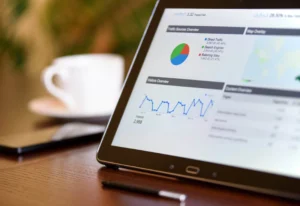What Is Procurement Management Software?

Your company’s procurement management software efficiently organizes all your procurement tasks from requisition to payment. Can easily be integrated with your ERP systems.
By automating procurement activities, like sourcing materials and processing invoices with procurement management software, it helps your team concentrate on strategic goals.
Using this software in your business can have advantages.
Let’s reduce costs by automating duties and discovering chances to save money.
Improving productivity by streamlining tasks and minimizing mistakes.
Enhance adherence to regulations, by ensuring that company guidelines and protocols are followed rigorously.
Enhance Your Decision-Making Skills by Utilizing spending data to inform your procurement decisions.
How Procurement Automation Reduces Costs?

Businesses greatly benefit from utilizing Procurement Management Software due, to factors making it a crucial component, in the procurement process.
Optimize Procure-to-Pay (P2P) Processes
Efficiently managing the procurement process from request to payment is vital for maximizing effectiveness in operations. Good Procurement Management Software streamlines the purchase, to pay processes reducing errors increasing speed and guaranteeing a seamless procurement cycle.
Streamline Supplier Management
Establishing relationships with suppliers is essential for a procurement strategy to be successful.
Vendor management software provides functionalities for evaluating vendor effectiveness and managing a database while enhancing transparency.
These skills result in making choices and negotiating efficiently while building stronger connections with suppliers.
Source-to-Pay (S2P) and Source-to-Contract (S2C) Optimization:
Improving the procurement process, from sourcing all the way, to making the final payment is crucial for reducing costs and meeting compliance requirements.
The software, for managing procurement enhances transparency and efficiency by automating purchase to pay (S2P) and source, to contract (S ̧2C) procedures while also lowering expenses.
Category Management
Strategic sourcing relies heavily upon the organization and oversight of procurement tasks, within teams or departments.
The software for managing procurement helps to examine spending information and discover chances to cut costs while supporting the execution of plans in these sectors. This results in choices and enhances overall performance.
What Are the 12 Key Benefits of Procurement Software?

Procurement software provides numerous advantages that can enhance your business’s procurement process, reduce costs, and boost efficiency.
Explore the 12 key benefits of procurement software for your business:
1. Reduced Procurement Costs
Introducing a procurement system, a company offers a benefit in terms of cost efficiency by automating tasks examining spending patterns closely and improving discussions with suppliers.
One significant factor in reducing expenses with procurement software involves automating tasks such as simplifying purchase requisitions and order processing; this can notably decrease labor expenses associated with time consuming responsibilities.
This boost in effectiveness does not reduce expenses but also empowers key human assets to devote their attention to higher level and more significant tasks, within the company.
2. Enhanced Efficiency
Incorporating procurement software can greatly enhance the efficiency of an organization.
By enhancing the procurement processes, through the software’s capabilities it streamlines tasks that’re manual, lessens errors and removes the need for paper records.
This effective approach accelerates the process of acquiring goods and services while also streamlining tasks such as request for purchases and handling orders automatically.
As a result of this improvement, in processes, within companies
3. Enhanced Compliance
Procurement tools are essential for enhancing adherence to regulations within companies.
It functions as a regulator by automating the enforcement of company policies and procurement processes guaranteeing that all purchasing actions comply with regulations and internal guidelines.
By using automated inspections and controls in place the software lowers the chance of non-compliance. Encourages a clear purchasing system.
By having the ability to monitor procurement activities in time and stay ahead of obligations with ease thanks to tracking features.
4. Enhanced Insight into Expenditure
Businesses leverage procurement software to better understand their spending patterns effectively.
This technology enables organizations to make informed purchasing decisions by providing up to date information on expenses and revealing trends and patterns.
Procurement experts can gain insight by accessing in depth spending details allowing them to fully understand how financial resources are distributed.
As a result of this process, it helps in making decisions of time by discovering chances to save money and ensuring resources are allocated efficiently.
5. Enhanced Supplier Management
Effective procurement software plays a role in enhancing supplier management for companies.
It provides a platform, for handling and nurturing relationships with suppliers within company’s operations and growth strategies. With tools such as monitoring performance metrics in place businesses can evaluate supplier input in a manner resulting in decision making processes.
The program offers an analysis of supplier performance indicators. Emphasizes key areas that require enhancements or streamlining.
Implementing procurement software can improve supplier management by enhancing transparency and minimizing risks while also promoting improvement in supplier relationships.
6. Improved Collaboration
Procurement software improves teamwork by promoting communication and coordination among procurement groups and potential suppliers.
This technology acts as a hub for teams to efficiently exchange information and maintain alignment among all members.
It streamlines the channels of communication to make it easier for procurement professionals to interact with colleagues from departments and work together seamlessly with suppliers.
7. Reduced Risk
Using procurement software improves teamwork by encouraging communication and coordination among procurement teams, across departments and potential suppliers.
This technology acts as a hub that helps teams share information efficiently and ensures that all team members are on the same page.
It makes it easier for procurement experts to communicate effectively with colleagues from departments and work seamlessly with suppliers by streamlining communication channels.
8. Enhanced Decision-Making
Businesses rely on procurement software to access data and insights essential for making purchasing decisions effectively. This technology. Analyzes information to offer a comprehensive understanding of procurement operations encouraging strategic decision making based on data analysis. Procurement experts can leverage real time data to assess supplier performance track spending patterns, identify cost saving opportunities, and implement cost reduction strategies in procurement.
9. Enhanced Agility
Utilizing procurement software greatly enhances a companys flexibility by allowing them to swiftly adjust to changing market dynamics and evolving customer demands.
This innovative technology brings adaptability, to purchasing processes. Enables companies to quickly respond to market fluctuations and changing customer needs.
By improving processes and providing insights, to users, in the procurement department your software helps them make informed choices effectively.
In todays changing business environment it is crucial for companies to be flexible, in order to navigate uncertainties and capitalize on emerging opportunities successfully.
10. Optimized Procurement Processes
Acquiring software is essential, for improving how acquisitions work by automating duties such as finding sources, for items needed and making requests and purchases easier to manage and execute efficiently. This Procurement Automation accelerates the acquisition process. Reduces the chances of mistakes linked with handling data manually.
The software simplifies tasks which helps create a more reliable work process, for procurement professionals to concentrate on important strategic activities effectively.
11. Decreased Administrative Load
Procurement software is a tool that helps procurement professionals by easing their tasks through automation of activities, like managing documents and approving invoices while also streamlining order processing tasks to minimize the reliance, on manual data input.
This automated system speeds up tasks. Greatly reduces the time and energy required for duties.
12. Enhanced Supplier Relationships
The program enhances communication and transparency between businesses and their suppliers by providing access to information, like orders and invoices.
The quick exchange of information fosters. Promotes teamwork, resulting in robust and efficient partnerships.
What Are the Potential Risks of Using Procurement Software?
Implementing procurement software can provide benefits for a company such as productivity, savings on costs and increased precision.
However it is important to acknowledge and deal with the dangers that come with carrying out the implementation process.
Integration Challenges
A significant concern is the level of intricacy required for integration.
The purchasing software needs to blend in with the existing systems and procedures in place; a task that can be quite complex and time-consuming, at times. This frequently requires custom development work which can raise the expenses of implementation and pose compatibility challenges.
Data Integrity
Another concern is the quality of data.
Accurate and reliable data are crucial for effective procurement management. If the software struggles with large data volumes or lacks robust data validation features, it can result in errors and inaccuracies, jeopardizing the decision-making process.
Resistance to Change
Implement procurement software comes with a risk. The resistance to change from employees accustomed to traditional procurement methods could hinder the successful adoption and utilization of the new technology.
Training Requirements and Costs
There is also a factor of risk related to training and the costs involved in it. Adequate training plays a role, in optimizing the advantages of the software and guaranteeing its utilization. Nevertheless training demands both time and investment, for companies.
Customization
Customizing things can sometimes come with its set of risks to consider well.
At times generic purchasing software may not completely meet the requirements and procedures of a company prompting the need, for customized adjustments..
Customizing these options may result in increased expenses. Could pose challenges when it comes to upkeep in the future.
Vendor Selection
Choosing the supplier is essential, for reducing hazards.
Choosing the vendor may result in data security risks, performance issues or inadequate support.
Before deciding on a vendor choice, organizations should thoroughly assess the vendors’ reputation, track record and security measures.
Data security
Data protection poses a threat, in this situation.
Cloud based purchasing software often handles information such as supplier particulars and financial data. Security safeguards are essential to protect this data from access or security breaches.
Measuring Performance
Measuring performance indicators is essential in assessing how well procurement operations are running in terms of both effectiveness and efficiency.
If the program doesn’t have reporting and analytic tools in place it might make it challenging for the organization to accurately track and evaluate performance.
Procurement software comes with advantages; however, it’s important for organizations to be mindful of the risks associated with it.
Challenges in this area encompass issues such as dealing with integrations and ensuring data quality while also facing resistance to change. The need for extensive training and associated costs along with concerns about customization options and selecting the right vendors while prioritizing data security and access to performance metrics.
To reduce these challenges and guarantee the integration of an electronic procurement system (e procurement) it is crucial to carefully plan and thoroughly assess suppliers while implementing effective strategies.